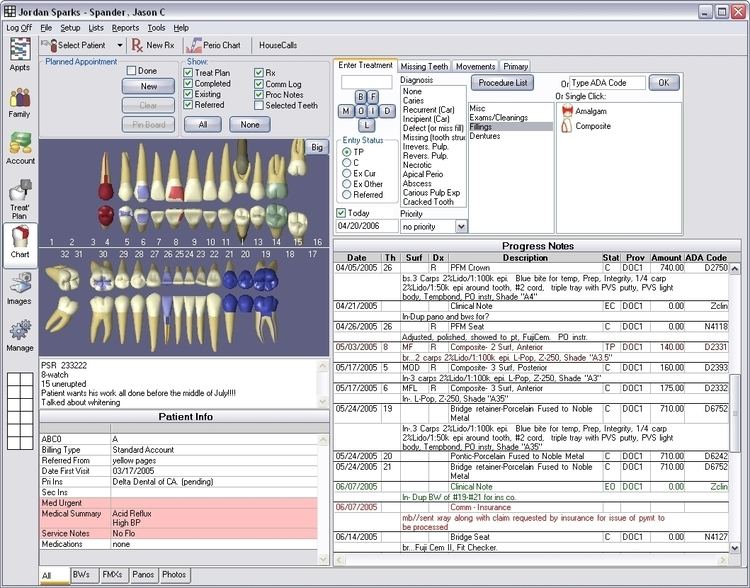Original author(s) | Written in C# | |
 | ||
Stable release 15.2 / July 20, 2015; 19 months ago (2015-07-20) Preview release 15.3(Beta) / July 20, 2015; 19 months ago (2015-07-20) Operating system Type Practice Management Software | ||
Open Dental, previously known as Free Dental, is a Practice Management Software licensed under the GNU General Public License. It is written in the C# programming language compatible with Microsoft .NET Framework and was first released in 2003. Current versions of the software require Microsoft Windows. Earlier versions of the software had supported other operating systems, but Linux support has been dropped. The full function version is only available under the commercial license because it includes royalty bearing, licensed materials from the American Dental Association (ADA), the Code on Dental Procedures and Nomenclature (CDT).
Contents
- Database
- Relational database benefits to dental practice
- Availability
- Mobility
- Retrievability
- Scalability
- Goals
- Appointment
- Family
- Account
- Treatment Plan
- Chart
- Images
- Manage
- References
Open Dental is owned and sponsored by Open Dental Software, Inc., which is incorporated in the State of Oregon in the United States of America. Being an open software, any programmer has the freedom to develop and support Open Dental. The company makes money through its monthly technical support features, which are required for at least the first 6 months of use. The first open dental customer bought the technical support services on July 22, 2003.
Database
The database uses the dual licensed MySQL database program. The structure of the data, or schema, is available for all to see and use (the data is still very secure). It is totally different than the proprietary format that all other dental software uses. Other programs can only export certain fields. In Open Dental, access to and control over every single piece of data is held by the dentist. Both local preferences and those which apply to every computer in the office will be stored in the mySQL database. This also greatly simplifies working with preferences and settings, and adding new workstations without having to spend all day setting them up.
The database schema is published and publicly viewable at http://www.opendental.com/OpenDentalDocumentation67.xml.
Relational database benefits to dental practice
There are documented benefits to using a relational database when storing and retrieving data: the relational model offers "advantages over the hierarchical and network models through its simpler data representation, superior data independence and easy to use query language". Open Dental gives the user those benefits over the non-relational platforms used by other dental practice management software programs.
Availability
Relational databases like Oracle and MySQL have mechanisms that can be used to keep the availability (of the database) very high. For instance, with MySQL replication, "the active primary database ships transactions to one or more standby databases. These standby databases apply the transactions to their own copies of the data. Should the primary database fail, one of these standby databases can be activated to become the new primary database". High availability is of clear importance when a customers (patients) have expectations of service at a particular time (an appointment). Open Dental provides replication support for users whose availability, mobility or multiple physical location needs demand it.
Mobility
Mobile dental programs have special needs including offline data collection, central data availability and public health reporting. All of these needs are met with Open Dental. An example of a mobile dental program that has published their experience using Open Dental is the St. David's Dental Program.
Retrievability
Structured Query Language (SQL) allows the user to pull data from the database for analysis. Open Dental provides over 250 user queries that have been requested by users, and advanced users may write their own queries to get specialized information from the database.
Scalability
Open Dental can be scaled from a single, one-computer user in a small office to dozens of computers per server over multiple physical locations.
Goals
The project wants "this software to become the world standard dental software. We want to make it easy to access and share data. We are tired of the restrictive policies of the current dental software companies. We want the user to always have total control, not the software company. And most of all, we want software that just works well”.
There are about 4,000 offices using OD, and an estimated 10,000,000 patient records.
Dr. Jordan Sparks has done most of the initial programming. They have a team of additional programmers employed these days.
